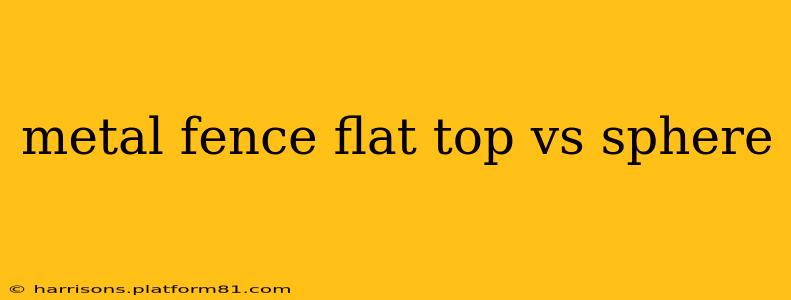Choosing the right fence can significantly impact your property's curb appeal, security, and overall value. When it comes to metal fencing, one key decision is the style of the top rail: flat top versus sphere top. Both offer distinct aesthetic and practical advantages, and understanding these differences is crucial for making an informed choice. This comprehensive guide will delve into the pros and cons of each, helping you decide which best suits your needs and preferences.
Flat Top Metal Fence: Clean Lines and Modern Appeal
Flat top metal fences project a clean, contemporary look. Their straight lines create a sleek, minimalist aesthetic that complements modern homes and landscapes. This style is often preferred for its simple elegance and versatility.
Advantages of a Flat Top Metal Fence:
- Modern and Sleek Design: The minimalist design fits seamlessly into modern architectural styles.
- Easy to Maintain: The flat surface is relatively easy to clean and requires minimal maintenance.
- Cost-Effective: Generally, flat top fences are slightly less expensive to manufacture than those with more intricate designs.
- Enhanced Visibility: Provides a clearer line of sight, which can be beneficial for security purposes in some situations.
Disadvantages of a Flat Top Metal Fence:
- Less Decorative: Compared to sphere top designs, flat tops lack the visual interest and ornate detailing that some homeowners desire.
- Potential for Injury: The sharp, flat top can pose a slight risk of injury if someone were to fall or climb on the fence. However, this risk is mitigated by proper installation and responsible use.
- Less Privacy: The lack of a decorative top rail can offer less visual privacy compared to other options.
Sphere Top Metal Fence: Ornate Design and Enhanced Security
Sphere top metal fences offer a more traditional, decorative look. The rounded tops add a touch of elegance and visual interest to the overall design. The curved shape also adds a level of security.
Advantages of a Sphere Top Metal Fence:
- Enhanced Security: The rounded top makes it more difficult to climb the fence, enhancing security and deterring intruders.
- Aesthetic Appeal: The decorative design adds a touch of elegance and sophistication to any property.
- Increased Privacy: The curved top can partially obscure the view beyond the fence, offering a degree of increased privacy.
- Durable and Long-Lasting: The rounded top is less prone to damage from impacts than a sharp, flat top.
Disadvantages of a Sphere Top Metal Fence:
- Higher Cost: Sphere tops generally cost more to manufacture and install due to the extra work involved.
- More Difficult to Clean: The curved surface may make cleaning slightly more challenging than a flat top.
- Less Modern: The decorative style might not be suitable for all architectural styles, particularly modern or minimalist designs.
What are the different types of metal used in fences?
Metal fences are typically constructed from materials like aluminum, steel, and wrought iron. Each offers unique properties in terms of durability, maintenance, and cost. Aluminum is lightweight, rust-resistant, and relatively inexpensive. Steel is stronger and more durable but requires regular maintenance to prevent rust. Wrought iron offers exceptional strength and durability, but it's the most expensive option. The choice of metal will also influence the overall look and feel of the fence.
Which type of metal fence is best for privacy?
While both flat top and sphere top fences can offer some degree of privacy, the sphere top design generally provides better privacy due to the partially obscured view from the rounded top. However, the level of privacy will also depend on the height of the fence and the density of the metal used. Solid panels offer the best privacy, while those with gaps between the rails allow more visibility.
How much does a metal fence cost?
The cost of a metal fence varies significantly depending on the type of metal, height, length, style, and installation costs. Sphere top fences generally cost more than flat top fences due to the added complexity of the design. Getting multiple quotes from reputable fencing companies in your area is essential to accurately determine the cost for your specific project.
How long does a metal fence last?
With proper maintenance, metal fences can last for many years. Aluminum fences are known for their longevity, often lasting 20-30 years or more. Steel fences can also last for a long time but require regular maintenance to prevent rust. Wrought iron fences are incredibly durable and can last for decades with minimal upkeep.
By carefully weighing the pros and cons of flat top and sphere top metal fences, and considering factors like budget, aesthetic preferences, and security needs, you can make an informed decision that best suits your property and lifestyle. Remember to consult with a fencing professional to get personalized advice and accurate pricing for your project.
